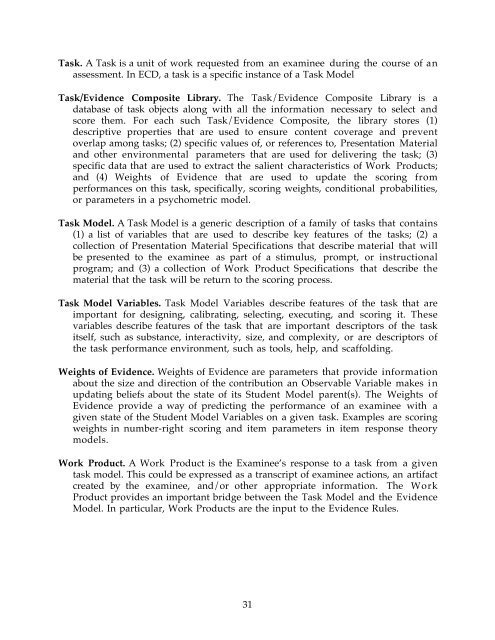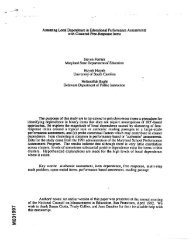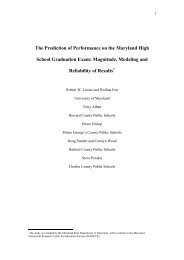A Brief Introduction to Evidence-Centered Design CSE Report 632 ...
A Brief Introduction to Evidence-Centered Design CSE Report 632 ...
A Brief Introduction to Evidence-Centered Design CSE Report 632 ...
Create successful ePaper yourself
Turn your PDF publications into a flip-book with our unique Google optimized e-Paper software.
Task. A Task is a unit of work requested from an examinee during the course of anassessment. In ECD, a task is a specific instance of a Task ModelTask/<strong>Evidence</strong> Composite Library. The Task/<strong>Evidence</strong> Composite Library is adatabase of task objects along with all the information necessary <strong>to</strong> select andscore them. For each such Task/<strong>Evidence</strong> Composite, the library s<strong>to</strong>res (1)descriptive properties that are used <strong>to</strong> ensure content coverage and preven<strong>to</strong>verlap among tasks; (2) specific values of, or references <strong>to</strong>, Presentation Materialand other environmental parameters that are used for delivering the task; (3)specific data that are used <strong>to</strong> extract the salient characteristics of Work Products;and (4) Weights of <strong>Evidence</strong> that are used <strong>to</strong> update the scoring fromperformances on this task, specifically, scoring weights, conditional probabilities,or parameters in a psychometric model.Task Model. A Task Model is a generic description of a family of tasks that contains(1) a list of variables that are used <strong>to</strong> describe key features of the tasks; (2) acollection of Presentation Material Specifications that describe material that willbe presented <strong>to</strong> the examinee as part of a stimulus, prompt, or instructionalprogram; and (3) a collection of Work Product Specifications that describe thematerial that the task will be return <strong>to</strong> the scoring process.Task Model Variables. Task Model Variables describe features of the task that areimportant for designing, calibrating, selecting, executing, and scoring it. Thesevariables describe features of the task that are important descrip<strong>to</strong>rs of the taskitself, such as substance, interactivity, size, and complexity, or are descrip<strong>to</strong>rs ofthe task performance environment, such as <strong>to</strong>ols, help, and scaffolding.Weights of <strong>Evidence</strong>. Weights of <strong>Evidence</strong> are parameters that provide informationabout the size and direction of the contribution an Observable Variable makes inupdating beliefs about the state of its Student Model parent(s). The Weights of<strong>Evidence</strong> provide a way of predicting the performance of an examinee with agiven state of the Student Model Variables on a given task. Examples are scoringweights in number-right scoring and item parameters in item response theorymodels.Work Product. A Work Product is the Examinee’s response <strong>to</strong> a task from a giventask model. This could be expressed as a transcript of examinee actions, an artifactcreated by the examinee, and/or other appropriate information. The WorkProduct provides an important bridge between the Task Model and the <strong>Evidence</strong>Model. In particular, Work Products are the input <strong>to</strong> the <strong>Evidence</strong> Rules.31






